Today we have perhaps one of the biggest announcements of the year from Intel’s server division with the launch of Broadwell-DE. The Intel Xeon D SoC completely revolutionizes the lower end of the x86 server market by bringing Intel’s first 14nm Broadwell cores to the server market along with a SoC design. The first Broadwell-DE SoC’s we will see launched are the Intel Xeon D-1540 and Xeon D-1520. The Intel Xeon D-1540 is an 8 core 2.0GHz base 2.5GHz (all core turbo) SoC with Hyperthreadning for 16 threads. The Intel Xeon D-1520 is a 4 core 2.2GHz base 2.5GHz (all core turbo) SoC with Hyperthreading for 8 threads. Both have a TDP of 45w. That may sound like quite a bit, however the SoCs integrate not just traditional processor cores, but also the PCH and a dual 10GbE network controller. The focus for the Xeon D family seems to be the dedicated hosting community, some of the web hosting market along with memcached/ redis hosting. For memcached and redis one would normally build higher density nodes, but the Xeon D can handle up to 128GB of DDR4 using RDIMMs.
Intel Xeon D / Broadwell-DE Basic Architecture
The Intel Xeon D architecture is now a SoC. Broadwell-DE seeks to integrate many of the features found both on higher-end Intel Xeon E5-2600 chips along with its latest 14nm manufacturing technology and high speed networking to build a low power package. This architecture is a revolutionary jump in Intel’s low power server offerings. Here is the Intel slide that highlights the architecture and some of the details.
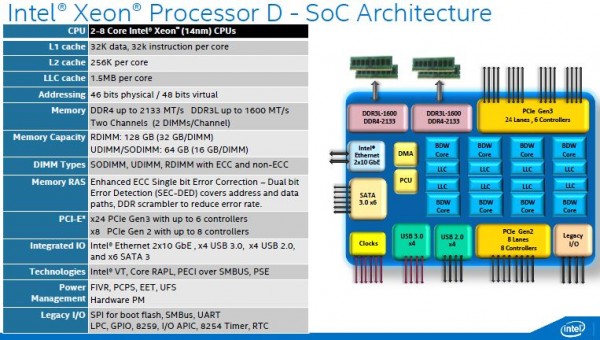
There are many key points on this slide. Here are a few highlights:
- Broadwell-DE employs Intel’s first 14nm Xeon cores and are based on the Broadwell architecture. These are now a generation ahead of the flagship Xeon E5-2600 V3 processors.
- There is support for either DDR4 or DDR3L and in UDIMM, SODIMM, and RDIMM configurations, up to 128GB using RDIMMs
- There are 24x PCIe 3.0 lanes (x16 and x8) that can be split down to 6 PCIe 3.0 x4 lanes – The Intel Xeon E3 only has 16 lanes so this is an increase of 50%
- The 8x PCIe 2.0 lanes can be split to 8 x1 for peripherals such as an ASPEED AST2400 BMC, additional LAN ports or other integrated hardware
- Integrated dual Intel 10GbE network for high-speed networking
- Integrated PCH so there is not a second PCH package like on current Xeon E3 and Xeon E5 platforms
- Virtualization, instruction and RAS features more akin to the Xeon E5 series than the Atom C2000 series.
In terms of performance, the Intel Xeon D is the first Broadwell based Xeon so it receives a number of IPC improvements.
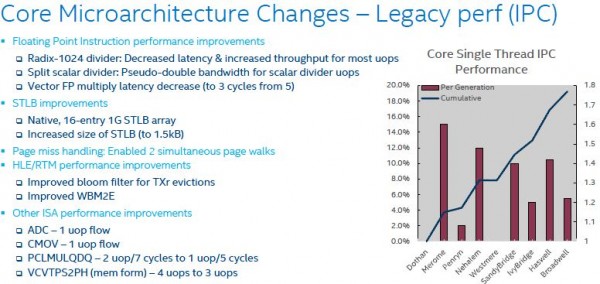
The impact here is that a 2.0GHz Broadwell-DE core should be about 5.5% faster or about the speed of a 2.1GHz Haswell core.
In addition, Intel is clearly moving to having more RAS features in the Xeon D.
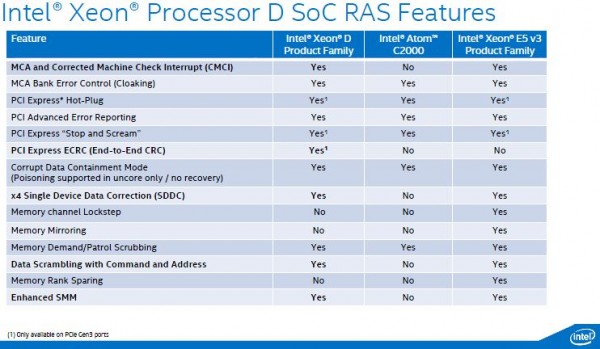
The major takeaway here is that unlike lower-power platforms of old where there was also a significantly reduced feature set, the Xeon D platform is built for higher uptime. The memory features missing do make sense since Broadwell-DE is limited to 4 DIMM slots. For example, mirroring across dual channel 2DPC would take too much performance away from the system.
Integration for power savings
The 6 port SATA controller and PCH functionality is likely closest to the Intel C22x series of PCH’s rather than the higher-end C612 PCH. The C224 for example has a TDP of 4.1w so platforms like the Intel Xeon E3-1200 v3 based platforms will have a PCH present that the Broadwell-DE platforms will not.
Aside from this, there is a dual 10GbE controller integrated into the SoC. The first designs we have seen from several OEMs either are using PCB based Ethernet connections for high-density designs or 10Gbase-T. A dual 10Gbase-T card such as the Intel X540-t2 has a TDP of 13.4w. The Integrated Intel NIC in Broadwell-DE will use the Intel driver stack and therefore be easy to integrate from a system perspective as well. The 10GbE controller supports features such as VMDq and SR-IOV as the Xeon D platform is meant for virtualization.
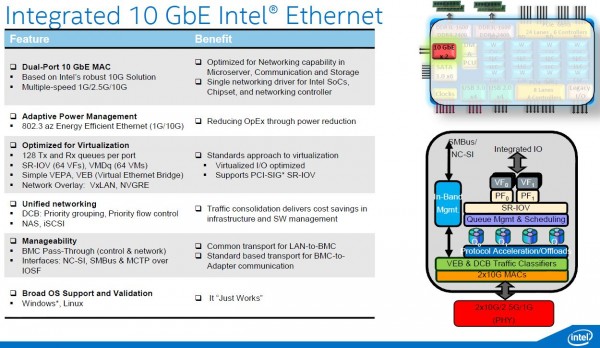
Between the PCH and the dual 10GbE integration, Intel is essentially moving 17.5w of TDP onto the chip. Comparing a Haswell-EP processor such as the Intel Xeon E5-2630L V3 (55w) to the 45w TDP for the 8 core/ 16 thread Intel Xeon D-1540 is a bit difficult. One could remove the TDP headroom for the PCH and network controller and get 45 – 17.5 = 27.5w TDP for the 8 core/ 16 thread Broadwell based processor. The E5-2630L V3 gets a quad channel memory controller but is clocked lower and is one generation behind in terms of IPC.
The other benefit Intel gets by moving all of this functionality is the ability to use hardware based power states.
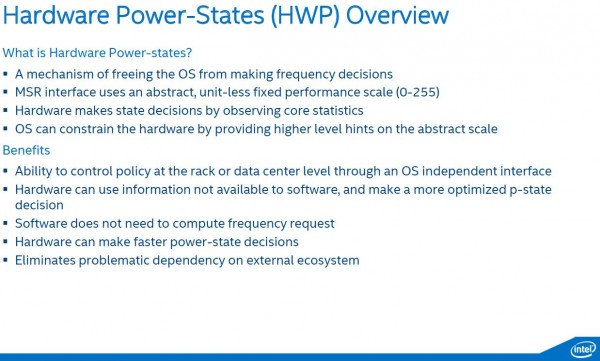
Intel has been moving more of the power control logic on-die and with Broadwell there is now a significant bonus even when the OS is not managing power.
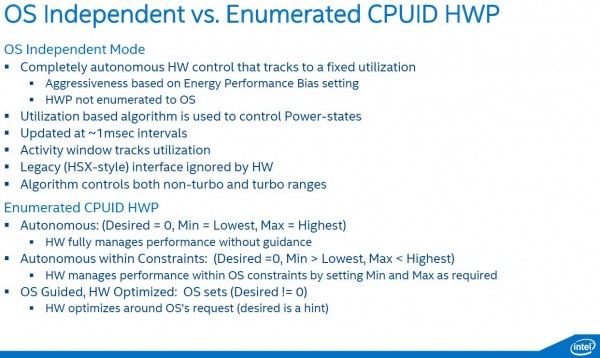
Intel is essentially taking over much of the SoC power management from OSes using HWP. Both the PCH and the NIC use older manufacturing processes, so their chips are less efficient than the state-of-the-art 14nm FinFET process Intel uses. With higher integration, greater logic and a smaller manufacturing process, Intel is changing the performance per watt game.
Example platforms
One request we hear often in the forums is for the power of Intel Xeon E5 in the mITX form factor. Broadwell-DE is the answer. For those wanting to build converged appliances such as VM hosts, virtualized router/ firewall appliances, and virtualized storage all in one box, Broadwell-DE will instantly be at the top of the list. Here is an example of the Supermicro X10SDV-TLN4F based on the Intel Xeon D-1540:
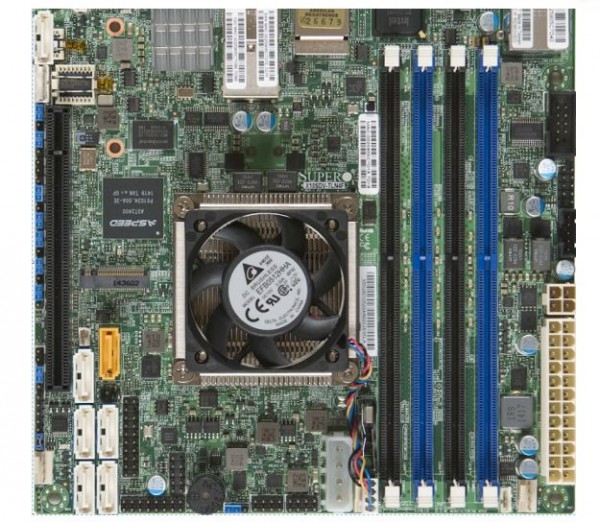
One can see from the picture snagged from embargoed documents that there is a PCIe 3.0 x16 expansion slot, a PCIe 3.0 x4 m.2 storage slot, dual 10GbE, dual 1GbE, 6x SATA III and 4x DDR4 DIMM slots that can take up to 128GB of RAM (4x 32GB) all in a mITX package. I did provide some feedback on potential future versions already.
Pricing and Availability
From what we have heard, mITX platforms based on Broadwell-DE will be in the $800 to $1000 range. That is frankly much higher than we would have expected from a Xeon E3 or Atom C2000 platform, but Intel seems to be using a different pricing methodology. If one takes a somewhat comparable Xeon E5-2630L at just over $600, add $200 for a single socket motherboard and around $500 for an Intel X540-t2 then pricing around $900 for the platform starts to make sense.
Some limited shipments are going out at launch in March of 2015 but vendors are telling us that mid-to-late April will likely see volume shipments. We have a few vendors working to get us examples as soon as possible. Expect benchmarks to come soon. One vendor we were at least slightly surprised to hear back from was Tyan. Tyan said they are not expecting to launch a Xeon D platform at this time. Other vendors had plans already in the works. Tyan’s business has changed and it seems that their focus is elsewhere.
Conclusion
On one hand, $800-1000 starting pricing is a bit higher than we would have expected using the Intel Xeon E3 as the base. On the other hand, compared to getting a single-socket Intel Xeon E5, this is relatively lower cost. The fact of the matter is that one will be able to build 8 core / 16 thread platforms, with 128GB of RAM, a PCIe 3.0 x4 SSD, several TB of SATA SSDs, dual 10GbE LAN and most likely even have room for a PCIe storage or network card and still fit well under 1A @ 120v. This compares to using an Intel Xeon E3-1270 V3 which is about 25% slower (we will confirm when we get samples), has 32GB RAM max and cannot handle 24 PCIe 3.0 lanes.
Get involved: Discuss the Intel Xeon D-1500 / Broadwell-DE launch on the forums

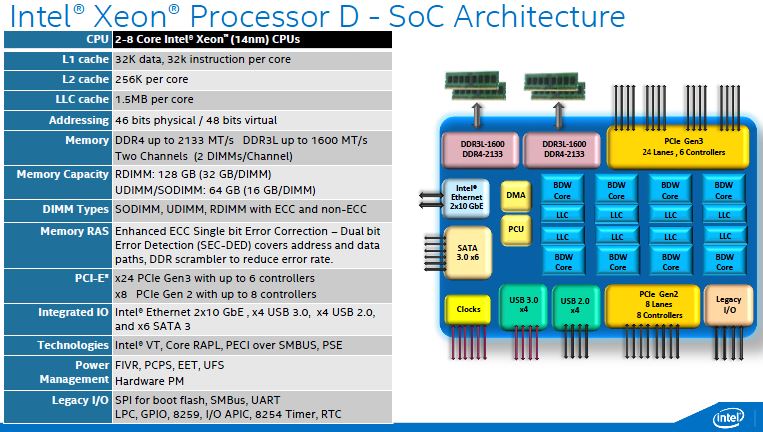



Patrick, you’ve given home virtualization lab enthusiasts a great reason to be excited about 2015, where we hopefullly are able to break past 32GB affordably, on an efficient, always-on VMware ESXi 6.0 system. Thank you!
Yes Patrick, thank you for designing and releasing this new hardware. Without you use home lab owners would be stuck in 32GB of RAM. You should continue to make more hardware!!!!!
This is a great Chip but I can not help think it would be better if the USB 2.0 was replaced by another two 10GbE Ports.